Volvo C30 2008 review
Looking to a green future, Volvo's latest C30 based concept debuts eye-opening technology.

The car is changing. New emissions targets, along with increased competition from emerging markets such as China, mean manufacturers like Volvo are being forced to innovate as never before. The C30 Recharge is a direct example of the work currently going on to meet those challenges, and is proof that despite the difficulty of developing such machines, the Swedish firm is well placed for success in the years to come.
It’s the most shocking new Volvo ever launched... And Auto Express is first behind the wheel. Part electric dream and part biofuel-powered hatchback, the C30 Recharge is the Swedish firm’s vision of the future, and it could go on sale as early as 2012.
Not content with building some of the safest cars on the road, bosses have created the Recharge as part of an effort to make the greenest, too.
The newcomer is best described as an advanced hybrid, with power coming from four electric motors mounted in the wheels. However, unlike some other hi-tech concepts, this one promises some serious advantages.
That’s because the energy to propel the car comes from three distinct sources. Rather than relying solely on battery power, the C30 Recharge also has a 1.6-litre biodiesel under the bonnet. This is attached to a large alternator to give an extra boost to the power systems. There’s no physical link between the engine and wheels, however; only an electrical one.
Used - available now

2019 Ford
Fiesta Vignale
44,100 milesManualPetrol1.0L
Cash £10,500
2022 Volkswagen
ID.3
33,043 milesAutomaticElectric
Cash £13,500
2023 Audi
e-tron
50,934 milesAutomaticElectric
Cash £18,900
2022 Dacia
Duster
49,300 milesManualPetrol1.0L
Cash £11,100The engine can therefore be run at its most efficient point to make power, rather than being forced to run to the very top of its rev range to provide forward motion. This not only improves real-world performance but also the kind of punch the electric motors need to keep up with fast-moving traffic.
The car can also be plugged into the mains at home to top up the battery, further extending the range. But if you were in any doubt about how advanced the newcomer is, consider this. The project only began towards the end of 2006, and debuts several important new innovations which will be absolutely key in transforming the Volvo from concept to reality.
First is the new battery pack, which uses silicium-polymer technology. The company’s engineers report that this arrangement is just as powerful as a lithium-ion set-up, but far more stable – a key consideration when it comes to ensuring the car’s safety. To improve the weight distribution, the batteries are mounted in front of the rear axle at the opposite end of the C30 to the diesel powerplant. This reduces the amount of luggage space available – although it really pays dividends when it comes to the handling.
The brakes are also highly advanced. As in-wheel electric motors are fitted, engineers had no room for conventional discs. And with so many hi-tech components nearby, there’s a real need to control the amount of heat generated when the car decelerates.
As a result, Volvo has turned its back on standard friction brakes, and will instead use the magnetic power of the electric engines to slow the car.
By running the powerplants in reverse when the brake pedal is pressed, Volvo says it can slow the C30 just as quickly as it would with standard brakes. And the bonus of this arrangement is that it can also be employed to recharge the batteries and reclaim the energy used in acceleration.
Yet there is still one major drawback to the C30’s appeal - its range. At present, Volvo says the newcomer will only manage 62 miles between charges. And although the addition of an engine significantly improves distances, owners would need to run it almost constantly to improve the range by more than 30 per cent.
Still, as bosses have so much time to refine the battery technology between now and the model’s intended launch, they are confident they can improve that figure considerably. And they will certainly need to.
With tough new emissions regulations planned, and countries such as Sweden close to turning their backs on oil almost completely, new thinking is certainly required – and Volvo’s C30 Recharge has plenty of that.







